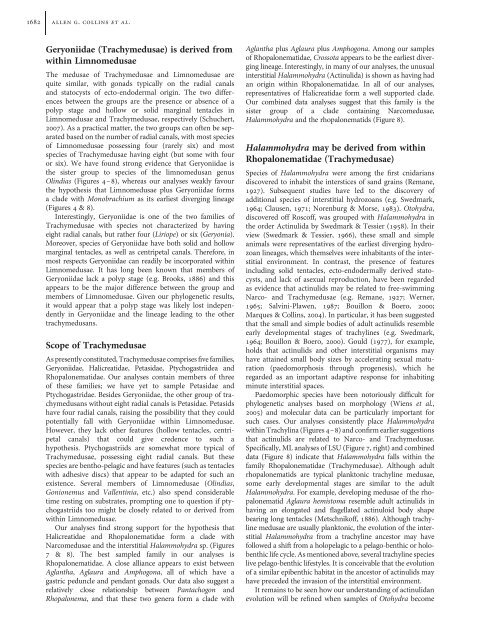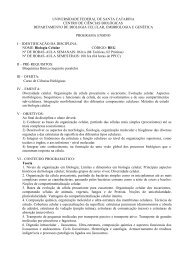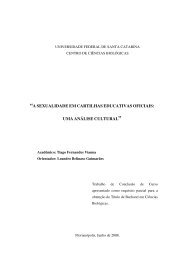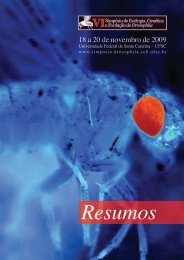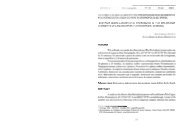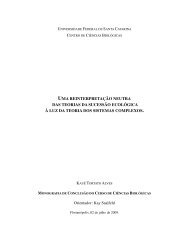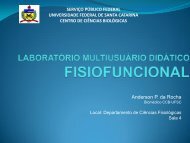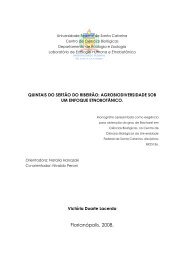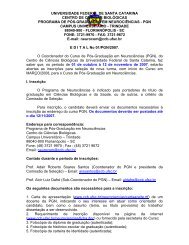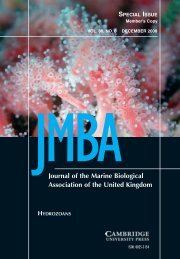Phylogenetics of Trachylina (Cnidaria: Hydrozoa) with new insights ...
Phylogenetics of Trachylina (Cnidaria: Hydrozoa) with new insights ...
Phylogenetics of Trachylina (Cnidaria: Hydrozoa) with new insights ...
- No tags were found...
You also want an ePaper? Increase the reach of your titles
YUMPU automatically turns print PDFs into web optimized ePapers that Google loves.
1682 allen g. collins et al.Geryoniidae (Trachymedusae) is derived from<strong>with</strong>in LimnomedusaeThe medusae <strong>of</strong> Trachymedusae and Limnomedusae arequite similar, <strong>with</strong> gonads typically on the radial canalsand statocysts <strong>of</strong> ecto-endodermal origin. The two differencesbetween the groups are the presence or absence <strong>of</strong> apolyp stage and hollow or solid marginal tentacles inLimnomedusae and Trachymedusae, respectively (Schuchert,2007). As a practical matter, the two groups can <strong>of</strong>ten be separatedbased on the number <strong>of</strong> radial canals, <strong>with</strong> most species<strong>of</strong> Limnomedusae possessing four (rarely six) and mostspecies <strong>of</strong> Trachymedusae having eight (but some <strong>with</strong> fouror six). We have found strong evidence that Geryoniidae isthe sister group to species <strong>of</strong> the limnomedusan genusOlindias (Figures 4–8), whereas our analyses weakly favourthe hypothesis that Limnomedusae plus Geryoniidae formsa clade <strong>with</strong> Monobrachium as its earliest diverging lineage(Figures 4 & 8).Interestingly, Geryoniidae is one <strong>of</strong> the two families <strong>of</strong>Trachymedusae <strong>with</strong> species not characterized by havingeight radial canals, but rather four (Liriope) or six (Geryonia).Moreover, species <strong>of</strong> Geryoniidae have both solid and hollowmarginal tentacles, as well as centripetal canals. Therefore, inmost respects Geryoniidae can readily be incorporated <strong>with</strong>inLimnomedusae. It has long been known that members <strong>of</strong>Geryoniidae lack a polyp stage (e.g. Brooks, 1886) and thisappears to be the major difference between the group andmembers <strong>of</strong> Limnomedusae. Given our phylogenetic results,it would appear that a polyp stage was likely lost independentlyin Geryoniidae and the lineage leading to the othertrachymedusans.Scope <strong>of</strong> TrachymedusaeAs presently constituted, Trachymedusae comprises five families,Geryoniidae, Halicreatidae, Petasidae, Ptychogastriidea andRhopalonematidae. Our analyses contain members <strong>of</strong> three<strong>of</strong> these families; we have yet to sample Petasidae andPtychogastridae. Besides Geryoniidae, the other group <strong>of</strong> trachymedusans<strong>with</strong>out eight radial canals is Petasidae. Petasidshave four radial canals, raising the possibility that they couldpotentially fall <strong>with</strong> Geryoniidae <strong>with</strong>in Limnomedusae.However, they lack other features (hollow tentacles, centripetalcanals) that could give credence to such ahypothesis. Ptychogastriids are somewhat more typical <strong>of</strong>Trachymedusae, possessing eight radial canals. But thesespecies are bentho-pelagic and have features (such as tentacles<strong>with</strong> adhesive discs) that appear to be adapted for such anexistence. Several members <strong>of</strong> Limnomedusae (Olindias,Gonionemus and Vallentinia, etc.) also spend considerabletime resting on substrates, prompting one to question if ptychogastriidstoo might be closely related to or derived from<strong>with</strong>in Limnomedusae.Our analyses find strong support for the hypothesis thatHalicreatidae and Rhopalonematidae form a clade <strong>with</strong>Narcomedusae and the interstitial Halammohydra sp. (Figures7 & 8). The best sampled family in our analyses isRhopalonematidae. A close alliance appears to exist betweenAglantha, Aglaura and Amphogona, all <strong>of</strong> which have agastric peduncle and pendant gonads. Our data also suggest arelatively close relationship between Pantachogon andRhopalonema, and that these two genera form a clade <strong>with</strong>Aglantha plus Aglaura plus Amphogona. Among our samples<strong>of</strong> Rhopalonematidae, Crossota appears to be the earliest diverginglineage. Interestingly, in many <strong>of</strong> our analyses, the unusualinterstitial Halammohydra (Actinulida) is shown as having hadan origin <strong>with</strong>in Rhopalonematidae. In all <strong>of</strong> our analyses,representatives <strong>of</strong> Halicreatidae form a well supported clade.Our combined data analyses suggest that this family is thesister group <strong>of</strong> a clade containing Narcomedusae,Halammohydra and the rhopalonematids (Figure 8).Halammohydra may be derived from <strong>with</strong>inRhopalonematidae (Trachymedusae)Species <strong>of</strong> Halammohydra were among the first cnidariansdiscovered to inhabit the interstices <strong>of</strong> sand grains (Remane,1927). Subsequent studies have led to the discovery <strong>of</strong>additional species <strong>of</strong> interstitial hydrozoans (e.g. Swedmark,1964; Clausen, 1971; Norenburg & Morse, 1983). Otohydra,discovered <strong>of</strong>f Rosc<strong>of</strong>f, was grouped <strong>with</strong> Halammohydra inthe order Actinulida by Swedmark & Tessier (1958). In theirview (Swedmark & Tessier, 1966), these small and simpleanimals were representatives <strong>of</strong> the earliest diverging hydrozoanlineages, which themselves were inhabitants <strong>of</strong> the interstitialenvironment. In contrast, the presence <strong>of</strong> featuresincluding solid tentacles, ecto-endodermally derived statocysts,and lack <strong>of</strong> asexual reproduction, have been regardedas evidence that actinulids may be related to free-swimmingNarco- and Trachymedusae (e.g. Remane, 1927; Werner,1965; Salvini-Plawen, 1987; Bouillon & Boero, 2000;Marques & Collins, 2004). In particular, it has been suggestedthat the small and simple bodies <strong>of</strong> adult actinulids resembleearly developmental stages <strong>of</strong> trachylines (e.g. Swedmark,1964; Bouillon & Boero, 2000). Gould (1977), for example,holds that actinulids and other interstitial organisms mayhave attained small body sizes by accelerating sexual maturation(paedomorphosis through progenesis), which heregarded as an important adaptive response for inhabitingminute interstitial spaces.Paedomorphic species have been notoriously difficult forphylogenetic analyses based on morphology (Wiens et al.,2005) and molecular data can be particularly important forsuch cases. Our analyses consistently place Halammohydra<strong>with</strong>in <strong>Trachylina</strong> (Figures 4–8) and confirm earlier suggestionsthat actinulids are related to Narco- and Trachymedusae.Specifically, ML analyses <strong>of</strong> LSU (Figure 7, right) and combineddata (Figure 8) indicate that Halammohydra falls <strong>with</strong>in thefamily Rhopalonematidae (Trachymedusae). Although adultrhopalonematids are typical planktonic trachyline medusae,some early developmental stages are similar to the adultHalammohydra. For example, developing medusae <strong>of</strong> the rhopalonematidAglaura hemistoma resemble adult actinulids inhaving an elongated and flagellated actinuloid body shapebearing long tentacles (Metschnik<strong>of</strong>f, 1886). Although trachylinemedusae are usually planktonic, the evolution <strong>of</strong> the interstitialHalammohydra from a trachyline ancestor may havefollowed a shift from a holopelagic to a pelago-benthic or holobenthiclife cycle. As mentioned above, several trachyline specieslive pelago-benthic lifestyles. It is conceivable that the evolution<strong>of</strong> a similar epibenthic habitat in the ancestor <strong>of</strong> actinulids mayhave preceded the invasion <strong>of</strong> the interstitial environment.It remains to be seen how our understanding <strong>of</strong> actinulidanevolution will be refined when samples <strong>of</strong> Otohydra become


